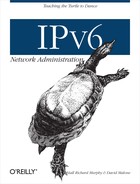Foreword
IPv6 has evolved during the last dozen years or so, and the road has not been easy. The process has been driven primarily by the shortage of address space under IPv4, but also by the desire for new applications that don’t fit within the older protocol’s limitations. The address space crisis has been delayed by several new approaches to IP addressing, the most important of them being CIDR, NAT, and RFC1918 private address space. At the same time, it was clear that these solutions only postponed the inevitable, so efforts began to redesign the IP protocol. These efforts led to IPv6.
Although CIDR, NAT, and private address spaces have been successful, they didn’t solve the problem—they only put it off. Today, the Regional Internet Registries have IPv4 address allocation policies that scare away those who would like to get public address space. IPv4 address space has become a scarce resource, and getting a public address block requires too much paperwork and bureaucracy. We can stretch out the IPv4 address space for 5, 10, or 50 years, but if the result is that only a privileged few can get public address space, what’s the point?
Enter IPv6. IPv6 provides a clean fix to the fundamental problem: too few bits in the IP address. The increased length of IPv6 addresses means that they can be assigned freely and used comfortably; they’re not a scarce resource that needs to be conserved. IPv6 also makes it possible to deploy new types of applications that rely on public address space, or that encode information in the IP address itself, such as multihoming and verifiably secure local networking.
The IPv6 specifications are now reasonably stable. Dozens of implementations have been deployed and used for years; if you want to use IPv6, you no longer need special software or patches. Most operating systems include IPv6 support, and some vendors even turn it on by default. IPv6 has arrived at a state where almost everyone can use it. The problem is now that they don’t know how.
Therefore, the most important work at the moment is enabling IPv6 deployment, and creating an atmosphere where IPv6 applications can be created and flourish. That’s where we’ll really see the benefit of IPv6: in new applications that go beyond the client-server paradigm, and take advantage of IPv6’s end-to-end addressing and connectivity features. That’s where this book comes in: it gathers knowledge scattered across the Internet about deployment and applications. There are many ways to deploy IPv6, and the more complex the network you have, the more possibilities you have. This book helps you to understand those possibilities and deploy IPv6 on your network.
Have the Internet users, application developers, and vendors grown too comfortable with short-term patches to counter the problem caused by NATs and address space shortage, instead of choosing the longer-term solution, IPv6? We’ll see.
IPv6 is ready for deployment. For you to deploy, use, and write applications for. This book shows you how; don’t let inertia hold you back. Have fun doing that!
IETF IPv6 Operations (v6ops) working group co-chair
